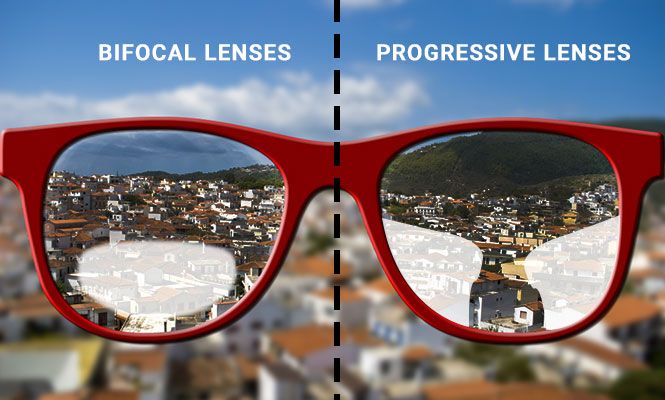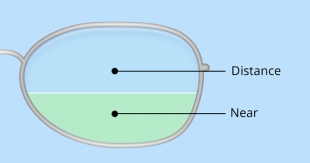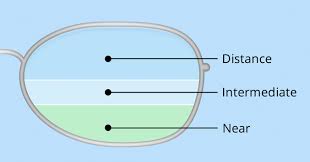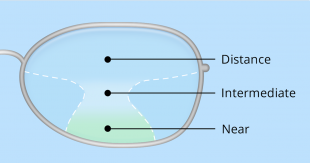

Some time after age 40, you will begin to notice the symptoms of presbyopia, including that feeling that your arms “aren’t long enough” to hold a newspaper or magazine at a position where you can read it clearly.
If you already wear prescription eyeglasses, this generally means you will need to begin wearing multifocal lenses to continue to see clearly at all distances.
While most presbyopes these days choose line-free progressive lenses, conventional bifocals and trifocals have some advantages over progressives. In particular, bifocal and trifocal lenses usually provide wider lens areas for reading and computer work than progressive lenses.
Also, there are many special-purpose bifocal and trifocal lens designs available, including special glasses for computers and for other tasks that require excellent intermediate and near vision.
Multifocal eyeglass lenses contain two or more lens powers to help you see objects at all distances after you lose the ability to naturally change the focus of your eyes due to age (presbyopia).
Bifocals contain two lens powers; trifocals have three. Progressive multifocal lenses gradually change in power from the top half of the lens to the bottom, and thus contain many lens powers.

Though multifocal lenses usually are prescribed for adults over age 40 to compensate for presbyopia, in some cases bifocals are prescribed for children and young adults who have eye teaming or focusing problems that cause eye strain when reading.
In these cases, the bottom portion of the bifocal lens reduces the amount of focusing effort required to see near objects clearly.
Also, some research suggests wearing bifocals or other multifocal lenses may help control myopia in some children by reducing the focusing demands of reading and near work.
Regardless of the reason you need a prescription for near-vision correction, bifocals all work in the same way. A small portion in the lower part of the lens contains the power required to correct your near vision. The rest of the lens usually is for your distance vision.
The lens segment (or “seg”) devoted to near-vision correction can be one of several shapes:
• A half-moon — also called a flat-top, straight-top or D segment
• A round segment
• A narrow rectangular area, known as a ribbon segment
• The full bottom half of a bifocal lens, called the Franklin, Executive or E style
Generally, you look up and through the distance portion of the lens when focusing on points farther away, and you look down and through the bifocal segment of the lens when focusing on reading material or objects within 18 inches of your eyes.
Trifocals have three points of focus — usually for distance, intermediate and near vision. The intermediate segment in trifocal lenses is directly above the near seg and is used to view objects at arm’s length.
Computers are an excellent example of something that is in a person’s intermediate zone. Motorists who need to see in the distance to drive, to see the gauges on the dashboard, and to read a map also would benefit from a trifocal.

Bifocal lens

Trifocal lens

Progressive lens
The most popular trifocal styles are the flat-top and the Executive.
Bifocals typically are placed so the line rests at the same height as the wearer’s lower eyelid.
As a bifocal wearer drops his eyes downward to read, the eyes naturally seek out the near-vision portion of the lens.
Trifocals are fitted a bit higher, with the top line of the intermediate seg placed even with the lower margin of the pupil.
A trifocal wearer looks through the intermediate zone when viewing something between 18 and 24 inches away. The eyes gravitate straight ahead, or up and over the multifocal segments, when gazing at something in the distance.
Bifocals and trifocals have visible lines, but the line in a round-seg bifocal tends to be less noticeable than the lines in flat-top and Executive styles.
There is something called an “invisible bifocal,” which essentially is a round-seg bifocal with the visible line buffed out. This blending process, however, causes some optical distortions.
If you want to wear a multifocal lens without visible lines, progressive lenses usually are your best choice.

For the best vision, comfort and appearance when wearing bifocals and trifocals, ask your optician about anti-reflective (AR) coating. In addition to eliminating distracting reflections, AR coating allows more visible light to enter the eye for night driving, and it makes the bifocal and trifocal lines in segmented multifocal lenses less visible because it reduces the amount of light reflecting off these junction lines.
Also, if you are sensitive to sunlight outdoors or spend a good deal of your day going in and out of the sun, ask your eye care professional about photochromic lenses. These light-sensitive lenses are clear indoors and quickly darken in response to sunlight to reduce glare. Photochromic lens technology is available in all multifocal lens designs, including lined bifocals and trifocals.
Source.Allaboutvision